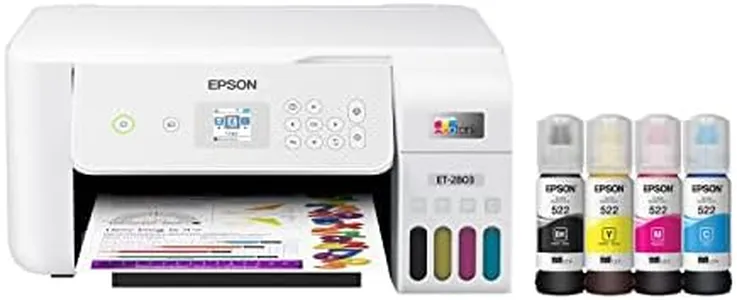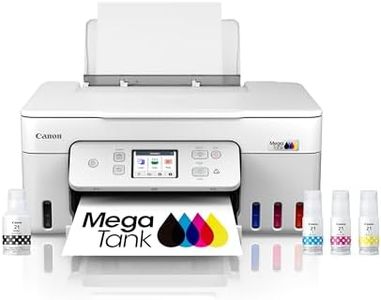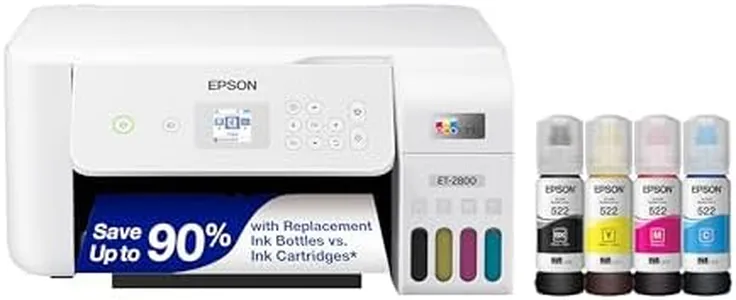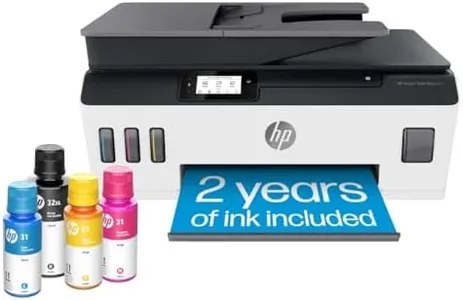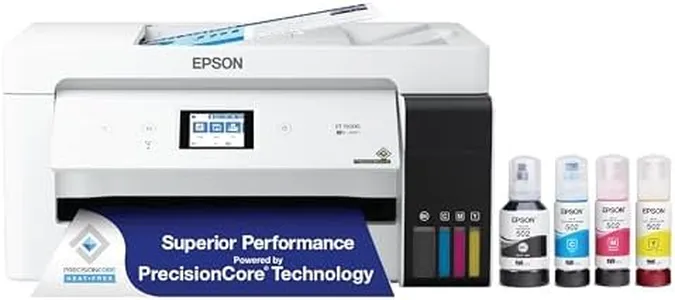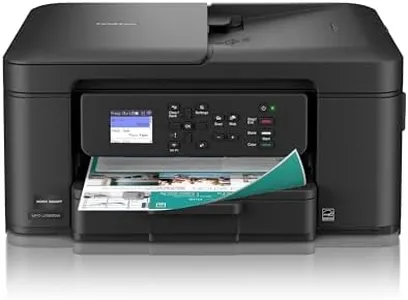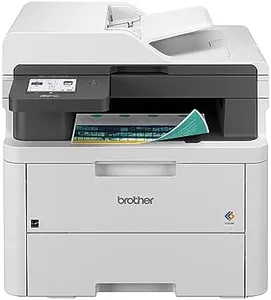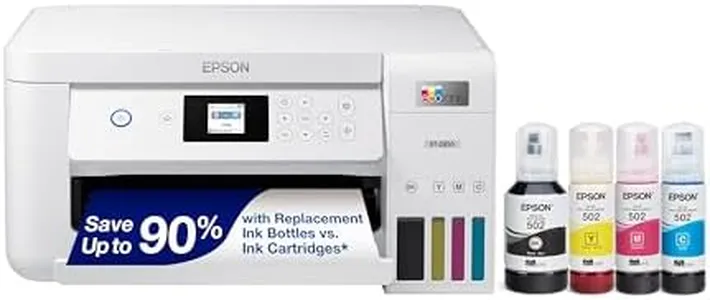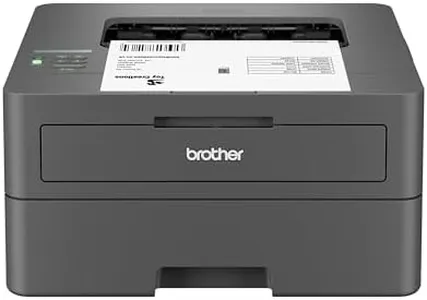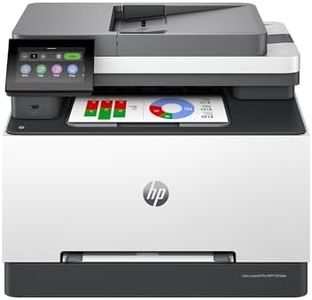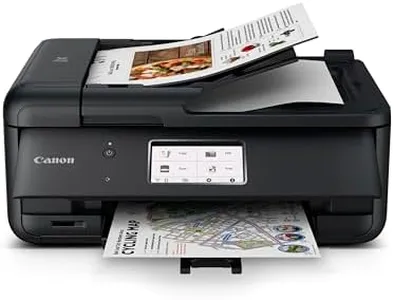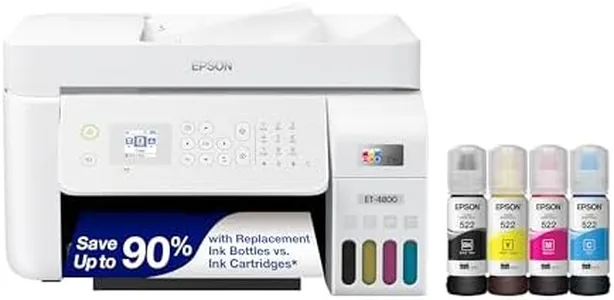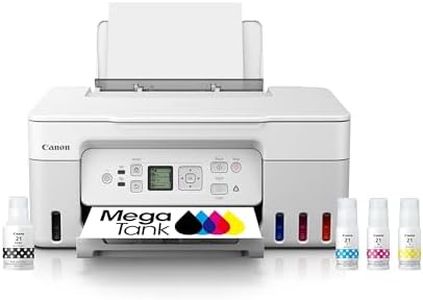10 Best At Home Printer 2025 in the United States
Our technology thoroughly searches through the online shopping world, reviewing hundreds of sites. We then process and analyze this information, updating in real-time to bring you the latest top-rated products. This way, you always get the best and most current options available.

Our Top Picks
Winner
Epson EcoTank ET-2803 Wireless Color All-in-One Cartridge-Free Supertank Printer with Scan, Copy and AirPrint Support
Most important from
18296 reviews
The Epson EcoTank ET-2803 is a wireless, all-in-one color printer that stands out for its cartridge-free printing system, which can save you a significant amount on ink costs. The high-capacity ink tanks and included ink set allow for up to 2 years of printing, reducing the hassle of frequent replacements. This printer is environmentally friendly by minimizing cartridge waste, and it prints up to 4,500 pages in black and 7,500 pages in color with the initial ink supply.
Its Micro Piezo Heat Free technology ensures sharp text and vibrant color prints on various paper types. Connectivity options are robust, featuring Wi-Fi and USB, alongside support for AirPrint and the Epson Smart Panel app for easy printing from smart devices. The built-in scanner and copier add versatility, making it a good fit for home offices or busy households.
However, the print speed is modest, with 10 pages per minute for black and 5 pages per minute for color, which might be slow for heavy users. Additionally, the printer lacks duplex (dual-sided) printing, which could be a drawback for those looking to save paper. Despite these limitations, the EcoTank ET-2803 is an economical and user-friendly option for those who prioritize long-term savings on ink and need reliable, quality printing for everyday tasks.
Most important from
18296 reviews
HP DeskJet 2827e Wireless All-in-One Color Inkjet Printer, Scanner, Copier, Best-for-Home, 3 Month Instant Ink Trial Included, AI-Enabled (6W7F5A)
Most important from
2346 reviews
The HP DeskJet 2827e is designed as a user-friendly, compact all-in-one printer ideal for everyday home tasks like printing documents, recipes, and letters. It uses color inkjet technology to deliver decent print quality, with a color resolution up to 4800 x 1200 optimized dpi on select photo papers, and a black-and-white resolution of up to 1200 x 1200 dpi. Its print speeds are modest—up to 7.5 pages per minute in black and 5.5 in color—making it suitable for occasional printing but not heavy or high-volume jobs. The 60-sheet input tray is convenient for home use but may require frequent refills if printing large batches. Connectivity options are strong, including reliable Wi-Fi with automatic troubleshooting, USB, Apple AirPrint, and Google Cloud Print support, plus wireless direct printing for easy smartphone use through the HP app.
This app also streamlines scanning and copying functions. Additional thoughtful features include a simple icon LCD panel and sustainability focus with 60% recycled plastic and energy certifications. However, duplex printing is only manual, which can be a drawback if you want automatic double-sided printing. The printer’s operation depends on original HP cartridges with built-in chips, and firmware updates may block third-party ink, which could increase ongoing ink costs despite the convenience of the included 3-month Instant Ink trial.
Its compact size and straightforward controls make it a good fit for most home environments where print volume is low to moderate and ease of use is key. It may not satisfy users needing fast output or heavy-duty functionality, but for general household printing, scanning, and copying, it delivers solid performance at a reasonable price point.
Most important from
2346 reviews
Canon Megatank G3290 All-in-One Wireless Supertank [Megatank] Printer | Print, Copy Scan | Mobile Printing |2.7" LCD Color Touchscreen | Auto Duplex
Most important from
4907 reviews
The Canon Megatank G3290 is an inkjet all-in-one printer designed for home use, offering printing, copying, and scanning with wireless connectivity. It uses a supertank system that includes enough ink to print thousands of pages, which can save significant money on ink over time—this is a big plus if you print regularly. The print quality is quite good, with sharp color and black-and-white outputs at a high resolution of up to 4800 x 1200 dpi, suitable for photos and documents. Its print speed is moderate—up to 11 pages per minute for black and white and 6 for color—so it's not the fastest but should be enough for typical home tasks. The printer features a 2.7-inch color touchscreen that makes operation straightforward, and automatic double-sided printing is convenient for saving paper.
Paper handling is simple with a single 100-sheet tray, supporting various sizes including photo and legal papers, which adds flexibility. Connectivity options include Wi-Fi and USB, allowing easy mobile printing from smartphones or computers. One limitation is that it has only one USB port and a single paper tray, so it might not suit very heavy or complex print jobs. Also, while the printer offers borderless photo printing, the print speed may feel slow if you need large volumes quickly. This printer represents a strong choice for home users who want low ink costs, good quality prints, and easy wireless setup, especially if convenience is prioritized over speed.
Most important from
4907 reviews
Buying Guide for the Best At Home Printer
Choosing the right at-home printer can make a big difference in your daily tasks, whether you need it for work, school, or personal projects. To find the best fit for you, it's important to understand the key specifications and how they align with your needs. Here are some important specs to consider when selecting an at-home printer.FAQ
Most Popular Categories Right Now


